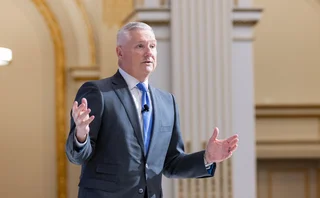
Waters Wrap: Exchanges Look to the Cloud (And More on ESG, M&A, and Vaccine Tracking Data)
As exchanges partner with cloud providers to move more functions to the cloud, Anthony wonders if these partnerships could become competitive in the future.
ICYMI: This week on WatersTechnology.com we gave you a deep-dive examination as to how exchanges might be able to move to the cloud, a look at how alternative data is helping investors track potential vaccines for the novel coronavirus, several stories about environmental, social, and governance (ESG) data and proprietary projects, and there was a bunch of market data news…let’s get to it.
Exchanges on the Cloud
*In the key of the Doors’ Riders on the Storm*
Our London-based reporter Hamad Ali spoke with execs from Nasdaq, London Stock Exchange, Amazon Web Services, Google Cloud, Microsoft Azure, and others to find out if exchange operators can move all of their exchange operations to the cloud. The caveat is that cloud delivery doesn’t support multicast delivery, and multicast is the accepted method for distributing data from one source to multiple recipients at the same time.
Exchanges still run their core infrastructure—their matching engines and broadcast feeds—on their own server farms on their own premises, but people like Nikolai Larbalestier, head of cloud strategy at Nasdaq, said that a full shift to the cloud is not a matter of “if” but “when,” and he thinks that the day we’ll see exchanges running on the cloud is coming sooner than many might think. To hear Nikolai’s thoughts in his own words, rather than bastardized by me, check out this recent episode of the Waters Wavelength Podcast.
Cloud providers might see big(ger) business in their futures if they can make multicasting in the cloud a reality. “Nobody is there yet, but I think that is the Holy Grail. And when somebody gets there, that is the capability that will unlock a huge amount of new cloud business in the capital markets,” Lee Bressler, who recently left Microsoft, told Hamad.
And Adrian Pool, head of financial services for the UK and Ireland at Google Cloud, told him that exchange data delivery is ripe for innovation, but that might not mean multicasting is the way forward. “Broadcast and multicast are both legacy networking technologies used for several decades. Communication protocols are ripe for innovation, and cloud offers an opportunity for the industry to re-imagine them,” Pool says.
As I wrote a few weeks ago, cloud continues to disrupt the capital markets. One of the biggest problems with “streaming” exchange market data in the cloud is the latency, or more specifically, that latency is not deterministic—i.e. the speed isn’t low-latency, nor constant, so messages can theoretically arrive out of sequence. Despite its imperfections, the exchanges will keep on dumping investment money into the cloud as they try to outpace one another. After all, no one wants to be the last, rotten egg.
Here’s my question, though: What happens when your cloud partner becomes your cloud competitor? Last year, Amazon launched the AWS Data Exchange to limited fanfare, but it’s an interesting play. Nasdaq also uses AWS for its Nasdaq Cloud Data Service (NCDS), a cloud-based delivery option for its most popular market data services. One could envision how this Data Exchange could eventually be seen as a competitive service for Nasdaq if AWS has success in growing the business. Similarly, CME Group is making real-time market data from all its marketplaces available via Google Cloud. But everyone loves Google until Google starts to think that maybe they can do your business better than you can.
Right now this is more conspiracy theory than substantive, and exchanges will have to be able to work with the likes of AWS, Azure, and Google Cloud if they don’t want to get outpaced in the innovation department. But they’ll also have to remember that when you answer the door, sometimes you get Little Red Riding Hood, and sometimes you get a wolf.
The Investment Scene
There was also some M&A news this week.
NovaSparks, which specializes in field-programmable gate array (FPGA) ticker plant and feed handler appliances, has a new backer, as Max Bowie reports. This deal will allow the vendor to double down on FPGAs while putting more functionality on them—not just data, but also more trading and pre-trade risk tools.
As Max reported earlier, in the pursuit of new ways to eliminate latency from the market data distribution and trading processes, vendors have invested in hardware-acceleration technologies like FPGAs. But with commodity chips now giving specialist hardware a run for its money, has that investment been wasted, or does each still have a role to play?
Also this week, Confluence announced that it has completed its acquisition of StatPro. Todd Moyer, Confluence president and chief operating officer, told Reb Natale that the company wants to become a fully cloud-native and cloud-enabled platform leveraging microservices and open-architecture technology as key components of its technology stack.
“I think the biggest change you’ll see from Confluence going forward is that, to us, it’s about ease of access to our technology,” Moyer said. “If you’re dealing with legacy solutions that have heavy installs and a lot of need for human involvement, we feel like that will accelerate the necessity to move everything into a truly cloud-native platform.”
For NovaSparks, the question going forward will be whether or not if found the right partner—one not just with money to invest, but one who understands the business that they’re in and “gets” their proposition from the get-go. For Confluence, it’s now more about making sure that the team is on the same page and that the talent that came over from StatPro is not just buying into that future state, but that they have a stake and a say in that future state.
Moyer told Reb that there have been “very limited” redundancies over the last nine months since the deal was announced. Most notable among those who have left was StatPro’s founder and CEO Justin Wheatley, who in December 2019, left the company that he helped build 25 years earlier. And a quick search of LinkedIn finds that Luca Bortolami, head of service delivery and former Revolution product director, left in Feb. 2020 after 12 years with the StatPro; Andrew Fabian, group finance director, left in December after almost 20 years with the company; and Ian Thompson, global director of portfolio analytics, left in March after almost 6 years. It should also be noted, though, that on StatPro’s “Meet the Client Services team” and StatPro’s “Our Staff” pages—which no longer exist after this week’s re-brand—all of those individuals are still there.
So for NovaSparks, will they get the investment and support they need to expand their FPGA dreams at a time when some are pulling back on hardware spend, and will Confluence use it’s experience and skills to make sure that legacy StatPro stays engaged? Stay tuned.
ESG, Round 2
Last week, I wrote about some of the skepticism I have toward ESG. In many ways, ESG reminds me of blockchain: a nice buzzword to help sell some tickets, but the actual benefits are a bit elusive. Well, I think that my reporters read that and decided to screw with me, as this week we published three more ESG-related stories—no respect, I’ll tell ya.
One of those aforementioned stories was about Causality Link’s plans to release a dedicated ESG dashboard later this year that will differ from typical ESG indexes and ratings on the market not only by decoupling the environmental, social, and governance factors from one another, but also by drilling down into the nuances of each factor.
“Sustainability will be a very different topic from fighting climate change even though it will be interlinked,” Haren says. “So I think it’s not going to just be ‘E’— ‘E’ is going to split into sustainability and greenhouse gas effects,” Pierre Haren, Causality Link’s CEO, told Reb.
To me, this is the way forward. Rather than bundling ESG together and coming up with a score, the key is in breaking down the E, the S, and the G into their various components, and building the correlations from there.
Also this week, Jo Wright drilled into how UBS Asset Management’s Concentrated Alpha equities team incorporates ESG into the investment process. It’s an interesting look at how the firm has to go through several steps to find value in ESG. Max Anderl, a portfolio manager on the Concentrated Alpha desk, also noted that the team will work with companies to help them to improve their disclosures, rather than just striking them from the portfolio. As an example, they recently worked with a fairly young online pharmaceutical firm.
“The company was flagged as high risk [on the dashboard]. It was a problem of disclosure, and we said, ‘We can overcome it.’ We had this conversation with the CEO, rather than the chairman. He fully acknowledged the issue, so we sent him examples of best practice disclosures, and he said he is committed to making better disclosures happen. With younger companies, sometimes it can be a bit of a burden for them: they were growing strongly, but they lacked resources and faced the kinds of challenges that young, growing companies have. Nevertheless, they said they would put more effort into disclosure,” Anderl says.
Hunt for the Cure
Speaking of pharmaceutical companies, Jo Gallagher had an interesting piece on the race to develop a Covid-19 vaccine and some of the alternative data providers tracking progress of today’s contenders.
The advancement of natural language processing (NLP) has helped to breathe life into health care data, accelerating its importance during the pandemic and likely beyond. For example, Lend-Rx Technology uses NLP to extract sentiment linked to Covid-19 vaccines and treatments on social media sites by tracking reactions to, say, their side effects or effectiveness. These lists are curated to include the likes of medical experts, analysts, or test candidates engaged in the different clinical phases.
Tim Harrington, CEO of Battlefin, told Jo that this type of alternative data is becoming quite popular. “Healthcare data is going to be one of the larger growth areas in the alternative data space just because so much of the market is going to be dictated by finding a vaccine or treatment, because that will have a significant effect on things like travel and going back to work,” Harrington said. “The US Federal Reserve can keep pumping money in and trying to make the market go up, but to see the full recovery and have confidence levels come back, you are going to need some type of vaccine.”
This is alternative data at its best: an unforeseen event unfolds and there are winners and losers—can alternative data help an investor become, and stay, a winner?
That’s it for this week, folks. See you next Sunday.
Further reading
Only users who have a paid subscription or are part of a corporate subscription are able to print or copy content.
To access these options, along with all other subscription benefits, please contact info@waterstechnology.com or view our subscription options here: http://subscriptions.waterstechnology.com/subscribe
You are currently unable to print this content. Please contact info@waterstechnology.com to find out more.
You are currently unable to copy this content. Please contact info@waterstechnology.com to find out more.
Copyright Infopro Digital Limited. All rights reserved.
You may share this content using our article tools. Printing this content is for the sole use of the Authorised User (named subscriber), as outlined in our terms and conditions - https://www.infopro-insight.com/terms-conditions/insight-subscriptions/
If you would like to purchase additional rights please email info@waterstechnology.com
Copyright Infopro Digital Limited. All rights reserved.
You may share this content using our article tools. Copying this content is for the sole use of the Authorised User (named subscriber), as outlined in our terms and conditions - https://www.infopro-insight.com/terms-conditions/insight-subscriptions/
If you would like to purchase additional rights please email info@waterstechnology.com
More on Data Management
The IMD Wrap: Beginning of the end for data audits?
This week, there’s exciting news for data bean-counters in the form of a partnership between two vendors that could change the way we view and track data usage and audits.
Symphony boosts Cloud9 voice offerings with AI
The messaging and collaboration platform builds on Cloud9’s capabilities as it embraces the AI wave in what CEO Brad Levy calls “incremental” steps.
MSCI counts the cost of bank M&A, looks ahead to custom indexes, AI
Cancellations of overlapping contracts following a bank merger put a dent in MSCI’s earnings, but management remains upbeat about the potential of recent acquisitions and new technology developments.
Nasdaq reshuffles tech divisions post-Adenza
Adenza is now fully integrated into the exchange operator’s ecosystem, bringing opportunities for new business and a fresh perspective on how fintech fits into its strategy.
This Week: HKEx's new derivatives platform; GoldenSource; Quonian-SimCorp, and more
A summary of some of the latest financial technology news.
Chris Edmonds takes the reins at ICE Fixed Income and Data Services
Edmonds is now leading ICE’s fixed income and data business as the rush to provide better data and analytics in fixed income builds.
Deutsche Börse democratizes data with Marketplace offering
Deutsche Börse Group is set to unveil its Marketplace, a one-stop data shop designed to simplify and streamline data acquisition and consumption for its clients, while also surfacing data from across the firm to its own users. Jan Stiebing and Sven…
DSB says industry is ready to meet UPI mandate ahead of deadline
The Unique Product Identifier will be required for certain OTC derivatives in the EU at the end of April, following US adoption in January.
Most read
- Chris Edmonds takes the reins at ICE Fixed Income and Data Services
- Deutsche Börse democratizes data with Marketplace offering
- Nasdaq reshuffles tech divisions post-Adenza








